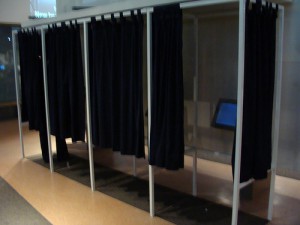Citing anti-competitive concerns, the Justice Department sued Election Systems & Software in order to force the company to divest itself of the voting machine assets it obtained from Premier Election Solutions last year.
The department’s antitrust division, along with nine state attorneys general, filed the civil antitrust lawsuit (.pdf) in U.S. District Court in Washington, D.C., charging that the acquisition threatened competition. The department proposed a settlement that, if accepted, would dissolve the merger and force ES&S to sell its Premier business to a buyer approved by the Justice Department.
“The proposed settlement (.pdf) will restore competition, provide a greater range of choices and create incentives to provide secure, accurate and reliable voting-equipment systems now and in the future,” said Molly S. Boast, deputy assistant attorney general for the antitrust division in a statement.
The nine states that joined the suit are Arizona, Colorado, Florida, Maine, Maryland, Massachusetts, New Mexico, Tennessee and Washington.
Last September, Premier (formerly Diebold Election Systems) announced that ES&S had purchased the company for $5 million in cash, plus 70 percent of revenue collected on existing accounts through the end of August 2009.
Even before the sale, ES&S, based in Omaha, Nebraska, was the nation’s largest voting-machine maker, with machines being used in 43 states. ES&S systems were “utilized in counting approximately 50 percent of the votes in the last four major U.S. elections,” according to the company’s website. The company also created statewide voter registration systems used in California, Maryland, Missouri, Nebraska and New Mexico.
Its acquisition of Premier, the second-largest voting machine maker with equipment used in 33 states, gave it a near monopoly on election gear and would have had the company providing 70 percent of voting equipment in the country. Premier was a division of Diebold, Inc, which is based in Canton, Oh.
Election integrity activists expressed concern at the time that the purchase would have a detrimental effect on competitive pricing for election districts and would also affect the development of accurate and secure voting systems, since ES&S would have little incentive to improve its voting systems without viable competitors. They were also concerned that ES&S would stop supporting the Premier equipment and try to pressure election officials who owned the equipment into purchasing ES&S machines.
Spokeswomen for Verified Voting and Voter Action declined to comment on the lawsuit or proposed settlement until their organizations have a chance to review the documents and discuss them with the Justice Department.
The settlement would force ES&S to divest itself of all intellectual property and means associated with producing all versions of Premier’s software, firmware and hardware as well as all inventory of parts and components.
ES&S must also grant to whoever acquires the Premier business a “fully paid-up, irrevocable, perpetual license” to use ES&S’s own AutoMark system. The AutoMark is a ballot marking device for disabled voters. Premier had obtained a limited license to sell the device prior to the acquisition. The buyer of the Premier business will be able to modify both the Premier products and the AutoMark system.
The proposed settlement would also require ES&S customers who are currently under contract to use Premier systems the chance to switch to the new buyer or remain with ES&S and obtain ES&S equipment. ES&S would be prohibited from bidding on new contracts for Premier equipment.
To make the transition smooth and avoid disrupting upcoming elections, ES&S must provide existing Premier customers with access to employees who are knowledgeable about the Premier systems and work out a supply agreement until the new buyer is able to take over manufacturing of the equipment.
ES&S said in a statement that it recognized that the acquisition had caused concern.
“With that in mind, we fully cooperated and have been working closely with the antitrust division of
the Department of Justice to address those concerns,” the company said. “We look forward to a resolution of this matter that will allow jurisdictions to move forward immediately in planning for upcoming election events.”
The company added that since the merger, it had provided support for more than 1,000 election events administered by former Premier customers.
Photo: Ben Sutherland/Flickr
See also:














